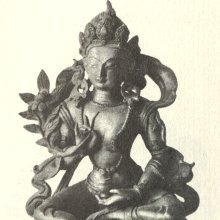Dharmavashita, Dharmavaśitā, Dharma-vashita: 4 definitions
Introduction:
Dharmavashita means something in Buddhism, Pali. If you want to know the exact meaning, history, etymology or English translation of this term then check out the descriptions on this page. Add your comment or reference to a book if you want to contribute to this summary article.
The Sanskrit term Dharmavaśitā can be transliterated into English as Dharmavasita or Dharmavashita, using the IAST transliteration scheme (?).
Images (photo gallery)
In Buddhism
Tibetan Buddhism (Vajrayana or tantric Buddhism)
Source: archive.org: The Indian Buddhist IconographyDharmavaśitā (धर्मवशिता) refers to one of twelve Vaśitā Goddesses, as commonly depicted in Buddhist Iconography, and mentioned in the 11th-century Niṣpannayogāvalī of Mahāpaṇḍita Abhayākara.—Her Colour is white; her Symbol is the bowl on lotus; she has two arms.
Dharmavaśitā is described in the Niṣpannayogāvalī (dharmadhātuvāgīśvara-maṇḍala) as follows:—
“Dharmavaśitā is white in colour and holds in her left hand the bhadraghaṭa (auspicious bowl) on a lotus of red colour”.
[These Vaśitās are collectively taken to be the spiritual daughters of the Dhyāni Buddha Amitābha. The twelve Vaśitā Goddesses [viz., Dharmavaśitā] are described collectively as two-armed, holding in their right hands the lotus and in the left proudly bearing their special symbols.]

Tibetan Buddhism includes schools such as Nyingma, Kadampa, Kagyu and Gelug. Their primary canon of literature is divided in two broad categories: The Kangyur, which consists of Buddha’s words, and the Tengyur, which includes commentaries from various sources. Esotericism and tantra techniques (vajrayāna) are collected indepently.
Mahayana (major branch of Buddhism)
Source: Wisdom Library: Maha Prajnaparamita SastraDharmavaśita (धर्मवशित) refers to “having obtained mastery over the Dharma”, according to the 2nd century Mahāprajñāpāramitāśāstra chapter 40.—Accordingly: [...] Furthermore, the Buddha is superior to the noble Cakravartin king. [...] Those who see the jewel of the wheel avoid calamities and torments; those who encounter the Wheel of the Dharma of the Buddha see the calamities and the torments of all wrong views and all doubts disappear. The king with his wheel governs four continents; the Buddha with the Wheel of the Dharma governs the entire world with its gods and men and makes them obtain mastery over the Dharma (dharmavaśita). These are the resemblances. [...]
Source: academia.edu: A Study and Translation of the GaganagañjaparipṛcchāDharmavaśitā (धर्मवशिता) refers to “mastery over (all) dharmas”, according to the Gaganagañjaparipṛcchā: the eighth chapter of the Mahāsaṃnipāta (a collection of Mahāyāna Buddhist Sūtras).—Accordingly, as Brahmā Prabhāvyūha address himself to the Lord: “O Lord, the greatness of the Bodhisattva Gaganagañja’s morality, concentration, supernormal knowledge, knowledge, insight, fulfilling vows, skillful means, highest intention, mastery of the dharma, ornaments for body, speech and thought, and mastery over all dharmas (sarva-dharmavaśitā) are marvelous! Since the Bodhisattva Gaganagañja has purified his former activities, he manifests all activities by body, speech, and thought without any effort [...]”.

Mahayana (महायान, mahāyāna) is a major branch of Buddhism focusing on the path of a Bodhisattva (spiritual aspirants/ enlightened beings). Extant literature is vast and primarely composed in the Sanskrit language. There are many sūtras of which some of the earliest are the various Prajñāpāramitā sūtras.
General definition (in Buddhism)
Source: Wisdom Library: Dharma-samgrahaDharmavaśitā (धर्मवशिता) or simply Dharma refers to the “mastery of dharma” and represents one of the “ten masteries of the Bodhisattvas” (vaśitā) as defined in the Dharma-saṃgraha (section 74). The Dharma-samgraha (Dharmasangraha) is an extensive glossary of Buddhist technical terms in Sanskrit (e.g., dharma-vaśitā). The work is attributed to Nagarguna who lived around the 2nd century A.D.
See also (Relevant definitions)
Partial matches: Vasita, Dharma, Tarma.
Full-text: Dharma.
Relevant text
No search results for Dharmavashita, Dharmavaśitā, Dharma-vashita, Dharma-vaśitā, Dharmavasita, Dharma-vasita; (plurals include: Dharmavashitas, Dharmavaśitās, vashitas, vaśitās, Dharmavasitas, vasitas) in any book or story.

